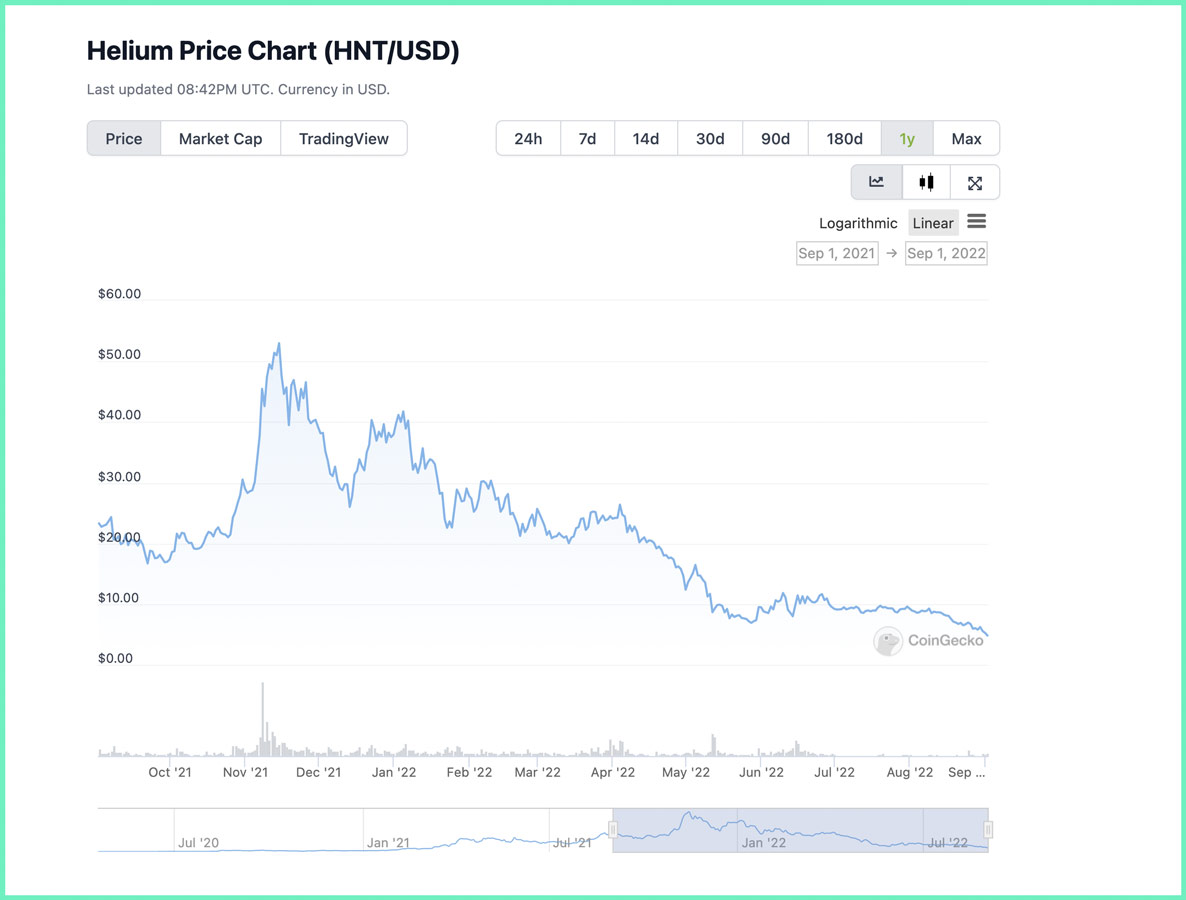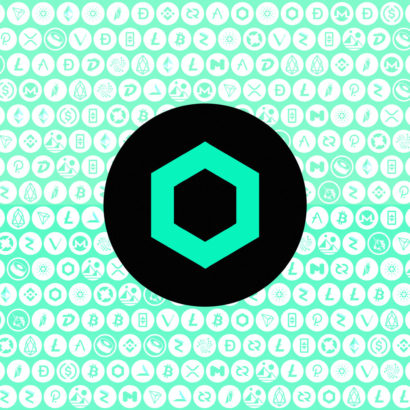This is an update on a previous article discussing Helium. In light of new information, the outlook is much dimmer and provides another important lesson about overhyping crypto projects.
Low Power Wide Area Networking (LoRaWAN) sounds like expensive high-tech stuff. Helium wanted to build decentralized networks, allowing devices seamless connection to the internet.
By incentivizing people to set up these hubs, Helium could distribute the network while allowing people to make money.
Sounds great right?
Actually, no.
Helium rose from just over a dollar in January 2021 to over $50 at its peak in November. But to technical experts, the value was never there.
The global LoRaWAN market share isn’t very high, estimated to reach more than $6 billion by 2026. At its peak in November 2021, Helium had a market cap of $5.5 billion in part because of the hype-cycle driven notorious venture capital pumpers at Andreessen Horowitz. The actual technology is quite limited – making it unsuitable for phone calls, streaming, or even controlling lights in your house.

Part of the pumping campaign involved claims that Lime and Salesforce were already using a technology. Like many other claims surrounding helium, this was later shown to be false.
Helium Promised to build the future of Decentralized IoT Networks and use Blockchain Technology to improve internet access.
The Problem:
Bandwidth is Unavailable In Remote Locations
Many different professions make use of electronic sensors and handheld devices; imagine researchers cataloguing wildlife and sequencing DNA in remote locations. The Internet isn’t readily available and it turns into a costly troubleshooting endeavor to get these networks set up.
With just about everything requiring internet access, many companies are racing to provide this bandwidth.
A Decentralized Network Secured by the Blockchain
Why This Doesn’t Work:
Anyone, including me and you, can buy a device from Helium that will let others connect to the internet. Instead of building large infrastructure or launching multiple satellites, the company can build up a faster and decentralized network by selling small devices directly to consumers.
But here’s the problem, the market share of the LoRaWAN space reveals a lack of demand at this scale.
The majority of these nodes aren’t set up in areas without available bandwidth and if multiple nodes were nearby, it would lead to competition between the setups. Helium recorded revenues of about $6500/month and relied on subsidizing people who hosted nodes because no one actually wanted to use the network. In part, this may be why they’re trying to pivot to 5G.
.@Helium, often cited as one of the best examples of a Web3 use case, has received $365M of investment led by @a16z.
Regular folks have also been convinced to spend $250M buying hotspot nodes, in hopes of earning passive income.
The result? Helium's total revenue is $6.5k/month pic.twitter.com/PyW6KPllvc
— Liron Shapira (@liron) July 26, 2022
A Brief History
Helium was founded in 2013 by Amir Haleem, Shawn Fanning, and Sean Carey to capitalize on future IoT technologies. This would help everything from smart pet collars, sentient blenders and malicious AI’s named Hal to connect to the internet. The network itself was launched in 2019 and has recently matured into an intriguing project, attracting enterprise investors including Google.
In a 2019 Decrypt interview, Haleem explained:
“We don’t try and participate in the network, and we don’t charge fees to use it. We incentivize others to become their own network operators. We nicknamed this thing the ‘people’s network.’ And that’s because it’s built by people.”
In this updated article, it is important to note that the financial incentives were heavily focused on participation into the network – leading to far more nodes than anyone could use. As a result, many validators are now only making $20/month – down from $100/month at its peak. This isn’t enough to compensate them for the cost of a node ($400 to $800).
Members of the r/helium subreddit have been increasingly vocal about seeing poor Helium returns.
On average, they spent $400-800 to buy a hotspot. They were expecting $100/month, enough to recoup their costs and enjoy passive income.
Then their earnings dropped to only $20/mo. pic.twitter.com/0jx2zLUaiA
— Liron Shapira (@liron) July 26, 2022
Meet the Team
Amir Haleem, Chairman and CEO:
Haleem has experience in video games as the CTO of Diversion and part of the original team involved in developing Battlefield 1942. He is a former esports champion gamer and founded the esports community site esreality.com.
Fanning and Carey are listed as board members; though they are co-founders of the company, they are not involved on an executive level.
Marc Nijdam, CTO:
Nijdam has 25 years of experience in the tech sector working to commercialize researchers with hardware companies like Hewlett-Packard. His role involves design, scaling, and overseeing software and development teams.
Frank Mong, COO:
Mong is involved in sales, marketing and business strategy at Helium. He has spent two decades working within various cybersecurity companies in management roles.
Initial Token Distribution
35 percent of Helium’s token, HTN, was distributed to investors and the company in the first year.
There isn’t more transparency on the official website so it is challenging to track whether the initial investors dumped the token at the peak.
Helium’s Roadmap
Helium has a transparent roadmap on its side, detailing its various goals, split across the various quarters and halves of 2021.
This is split into a few separate categories and goals:
Core features
Helium is involved in iterating and improving its validator protocols as well as enabling staking on the mainnet. In addition, they are developing Proof-of-Coverage protocols using network graph analysis to ensure that wireless network coverage is honestly represented.
Coverage
Helium wants to continue expanding its coverage to millions of devices. As well it is working on improvements to its Helium Wallet app for storing and receiving its cryptocurrency HNT, other credits, and managing hotspots.
Enabling Wireless Protocols and Blockchain Applications:
This year, Helium is undertaking an expansion in the wireless protocols which they provide. Currently, it supports broadband for low-power IoT devices. In 2021, Helium aims to enable LTE/5G, WiFi as well as other networks. There is also a lot of technical detail about improving the blockchain applications of the project itself.
Helium’s Utility
The network is already compatible with LoRaWAN devices which are important for IoT sensors (though the reach of the signal is limited and as discussed earlier, there isn’t sufficient demand). You can also find available coverage for roaming through a crowdsourced roadmap.
The HNT Wallet is available for iOS and Android phones and is paired to various Helium Hotspots. It also stores data credits and HNT tokens; it can also run through the ledger hardware wallet.
Supporting the Network
By helping secure the network through mining, you can earn HNT rewards while expanding internet coverage. However, this will involve buying specific devices and may be difficult if you don’t have experience with setting up wireless networks.
Staking and Validation
You can stake your HNT by delegating it towards a validator node; these nodes will use Proof of Coverage and Proof of Location protocols to ensure that information about hotspots is accurate and secure.
Proof of Coverage: This takes advantage of the properties of radio frequencies to interrogate and validate the network capabilities. Basically, it is always checking to see that nodes are working as they should be and that none of them lie about their support and capacity. Validators will receive a reward in HNT for providing this service. Unfortunately, there are plenty of bad actors taking advantage of this protocol, essentially receiving rewards without providing legitimate services.
Helium’s Market Milestones
Helium has a circulating supply of over 101 million tokens, with a total of 223 million tokens that will ever be issued; these remaining tokens will be distributed as rewards through Proof of Coverage. The price peaked at just over $50 USD at the end of November 2021.
Helium recently announced a partnership with Dish Network for developing its 5G network capabilities.
Mong explained: “Dish understands the potential blockchain can have on the wireless industry, and as the first major carrier to join The People’s Network, this partnership is real validation that the HNT incentive model is a powerful tool for deploying infrastructure at scale.”

Partnerships shown on Helium’s site
Well it turns out that many of the partnership claims made by Helium weren’t true. On the site, they claimed that the technology was deployed by Lime and Salesforce.
“Beyond an initial test of its product in 2019, Lime has not had, and does not currently have, a relationship with Helium.” Lime senior director for corporate communications Russell Murphy said to Mashable. The test lasted at most a month or two according to Murphy. Two and a half years ago, Lime told Helium that they didn’t want to be on any of their promo material which states that their technology is “trusted by Lime”. Salesforce also denied having any ongoing relationship with the company.
The response for Haleem was weak, implying that their team didn’t do any diligence in following up with their clients (no, a short trial and requests not to be featured on the website doesn’t mean the company is a trusted user).
we’ve worked with companies big and small over the years. lots of these engagements are pilots and trials, sometimes they turn into bigger applications and sometimes they don’t. there’s a lot of experimentation and collaboration involved and we’ve worked hard with those teams
— amir.hnt (🎈,🫡) (@amirhaleem) August 1, 2022
This leaves everyone wondering whether any of their other partnerships are also legitimate. A quick Twitter search for the terms: helium (from:@dish) showed that the official account of the DISH network never tweeted about the partnership.
Fair to say that you should take any claims about their entry into the 5G wireless space with a seriously large grain of salt.
Buy and Store HNT
Buying HNT
You probably shouldn’t buy HTN given their disastrously low revenue and lack of actual adopters.
| Binance | Crypto.com | |
| Ease-of-Use | ✔✔✔ | ✔✔✔✔✔ |
| Trading Fees | Up to 0.1% for spot trading | Up to 0.8% for spot trading |
| Payment Method | Debit or Credit Card | Debit or Credit Card |
| Recurring Buy? | Yes | Yes |
| Other Notes | Subject to regional restrictions in Canada | Promotion, when you join, waives fees for 30 days |
Storing HNT
If you’re planning to use Helium on its network, you’ll need to use the Helium wallet. The wallet can be installed onto your phone or onto a Ledger hardware device for cold storage; this is probably the most secure way to store and use the crypto.
| Hot Wallets | Cold Wallet | |
| Wallet | Helium Wallet | Ledger |
| Supported Platforms | Command Line Interface Android, iOS, | Connects to any computer via USB |
| Supported on Cold Wallets? | Yes – Ledger | |
| Mobile App Available | Yes | No |
| Initial Setup | 10 – 15 mins | |
| Non-Custodial | Yes | Yes |
| Staking | Yes | Yes |
The Case for Investing
There isn’t one.
Helium’s market cap was overinflated to the point where it mirrored the estimated demand of the entire LoRaWAN market! The majority of the money being made from people that host nodes is subsidized by the company and isn’t enough to recoup the cost of getting a mining rack.
Cons:
While there is an interesting use case for IoT and sensors, it isn’t clear that the blockchain aspect of the project is actually functioning. Proof of Coverage has a problem right now as it is “hackable”, allowing people to collect rewards without providing legitimate services for the network.
The hotspot hardware itself is also expensive (~$500), and even though it lets you mine some crypto you won’t earn much unless there are multiple other hotspots in the area. Another company might be able to provide similar sources with tethering internet hotspots with decentralized devices but without actually using the blockchain.
Conclusion
Don’t buy Helium.
It is out of air with no room to go up.
Their tech isn’t very impressive and they stated that Lime, a company that trialled the network for a month or two before ceasing, relied on the network. Another company, Salesforce, also asked to be removed from their site. A mining rig costs a lot of money and it will probably never recoup the cost at this point.
The company has mislead investors about its partnerships – at worst this financial malfeasance and at best, incompetence.
Sources
Sources
Liron Shapira tweet thread:
.@Helium, often cited as one of the best examples of a Web3 use case, has received $365M of investment led by @a16z.
Regular folks have also been convinced to spend $250M buying hotspot nodes, in hopes of earning passive income.
The result? Helium's total revenue is $6.5k/month pic.twitter.com/PyW6KPllvc
— Liron Shapira (@liron) July 26, 2022
.@Helium's CEO @amirhaleem and investor @KyleSamani replied to my thread about Helium
They didn’t deny the shocking data I shared, or explain why the project failed so bad.
But I appreciate their willingness to have an open Web3 debate. Sorely needed.https://t.co/owbnlEYw0R pic.twitter.com/px5Gp2Frs5
— Liron Shapira (@liron) July 27, 2022
Salesforce logos disappear from Helium website:
https://mashable.com/article/helium-removes-lime-and-salesforce-logos





